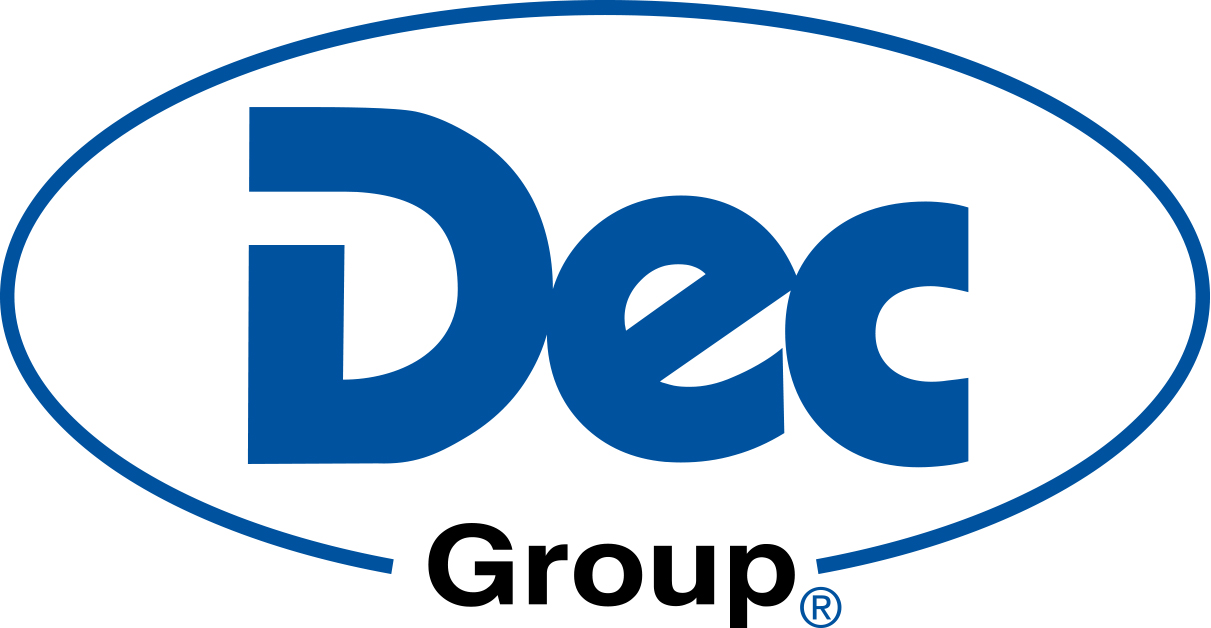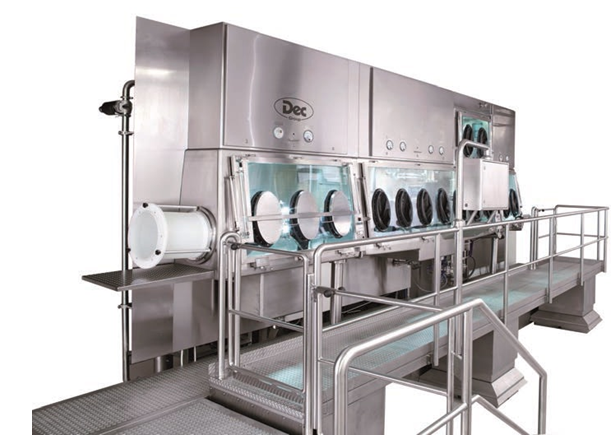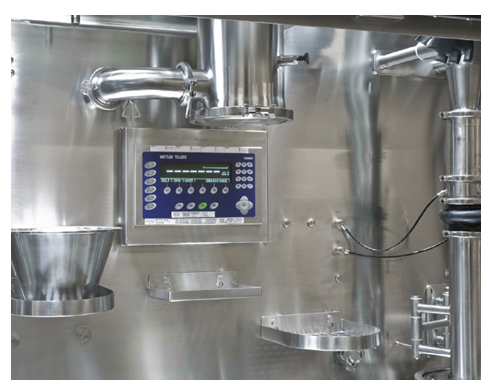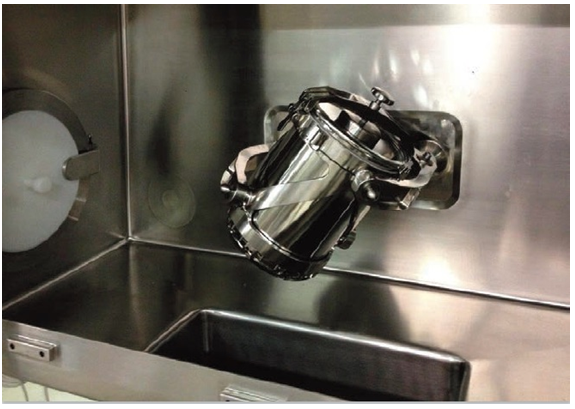By Dec Group
Dec Case study: High containment pharma production
Switzerland’s Dec Group is recognized as a world-leading expert in process containment technologies, based on its Powder Transfer System (PTS).
Dec’s latest case study shows how its contained powder handling systems and isolator technology can be combined to provide a custom-fit high containment pre-blending and transfer solution.
This delivers the high safety and containment levels required when handling high potency active pharmaceutical ingredients (HPAPIs).
Background
A leading Swiss pharma manufacturer decided to respond to growing global demand of inhalation products with investment in more advanced production facilities emphasizing greater safety and sustainability. Dec’s contribution to the project was the design and supply of several isolator systems to handle dry powder excipients plus HPAPIs under very high containment.
The task consisted of weighing and sieving HPAPI and excipient powders and transferring them into intermediate bulk containers (IBCs) ready for final blending.
Specialized containment was needed to make sure that highly active ingredients posed no risk either to operators or the environment.
Isolators therefore had to ensure operator exposure remained under 0.4 g per cubic meter of air OEL calculated on time weighted average (TWA) over eight hours.
Solution
Dec designed its solution around a multiple stage isolator system in which each contained chamber would play a key role in the two process stages required to pre-blend and transfer dry powder materials in readiness for final blending.
- Stage 1. Pre-blending: A Turbula blender integrated into the first isolation stage is used to perform manual pre-blending of HPAPIs and excipients. From here, pre-blended materials are discharged via a split butterfly type containment valve into an intermediate bulk container (IBC). A load cell-mounted lift platform is used to raise the blend IBC for docking to the ball valve connecting it to the next stage.
- Stage 2. Excipient transfer and weighing: The Powder Transfer System (PTS) with integrated Dosivalve mounted inside the isolator enables the automated transfer and dosing of excipients that are contained in an external intermediate bulk container (IBC). These excipients are transferred into the docked blend IBC to a predetermined set point weight. The required target weight is achieved using a controlled feedback loop between the Dosivalve and the lift platform load cell. The isolator is mounted above ground level on a platform with a staircase to enable easy operator access to the isolator chambers, while also connecting to IBCs of up to 1,000 liter capacity to the underside of the isolator. The high containment system is built into the process room wall, creating a technical area around the rear of the machine that can be accessed from a separate entrance.
- Transfer Chamber: Chamber 1 is designed as a secondary level of containment used to transfer APIs and excipients into the isolator for the dispensing, sieving and pre-blending process. An interlocked transfer door in the right hand wall of Chamber 1 connects it to Chamber 2 — where the dispensing and sieving is carried out. Contained transfer into the chamber is guaranteed through the use of a Rapid Transfer Port (RTP), which is mounted into the left hand side wall.
- Dispensing and Sieving Chamber: For dispensing and sieving, Chamber 2 is designed as the primary level of containment and is equipped with a raised central section mounting the PTS and integrated Dosivalve assembly. This assembly is used with a swing arm, which enables the transfer and dosing unit to be moved to the side, to permit manual charging of the pre-blend material. A vibratory sieve is mounted onto a frame to allow for the easy connection of PE bags onto the sieve. Its lower location improves manual handling and ergonomics. The chamber also includes high precision weigh scales that are recessed into the isolator work surface, thus permitting ledge-free transfers into the chamber. It also includes a powder collection system, further developed to function without the need for an externally mounted extract blower and additional filtration.
- Pre-blending Chamber: Pre-blending takes place in Chamber 3, which hosts a through-the-wall 17 litre Turbula mixer. For safety reasons with rotating machinery, the internal transfer door is interlocked during operation and an external glove port barrier is provided. This chamber connects with Chamber 2 via an interlocked internal transfer door mounted on the left-hand side wall of the chamber.
- Waste Management:
- Contained transfer of waste packaging materials and remaining products from the isolator is provided through an RTP, which is mounted into the right hand side wall and which is equipped with an endless liner system.
Cleaning features
The isolator and process equipment have been designed for wash in place (WIP). Each chamber can be connected to an external clean in place (CIP) system. The PTS and Dosivalve assembly including transfer lines are fully CIP, enabling cleaning liquids to be transferred through the transfer lines, through the PTS and Dosivalve and discharged directly through the split ball valve. All chambers are equipped with both fixed rotating spray nozzles designed for removal of gross (heavy) contamination of the isolator and a low velocity hand held spray gun. For fast drying, the isolator has been equipped with hot and forced air drying systems.
Isolator Key Features
- Large stainless steel operator access platform and gantry around the isolator with IBC docking in the center of the isolator
- Chamber 1: interlocked transfer chamber with RTP transfer and internal transfer door into chamber 2 with inflatable seal
- Chamber 2: dispensing & sieving chamber with base formed into a gully to house weigh scale, while also housing both dispensing and sieving process equipment with dedicated environmental control system
- Chamber 3: blending chamber with integrated, through the wall Turbula blending and external glove guard, RTP endless liner port and internal transfer door into chamber 2 with inflatable seals
- The high containment systems are designed to work within an ATEX 2G/1 IIB T4 hazardous process room, working at negative pressure using “once through” ventilation to meet cGMP standards
Conclusion
There is a growing trend for reliable containment solutions that provide product and environmental safety as well as efficient powder handling, without unnecessary interfaces. The selection of suitable technology is crucial for the success of each project. Dec is a competent provider with more than 30 years of industry experience of such containment solutions.
Dec’s Powder Transfer System (PTS) provides a thoroughly engineered integrated system for safe handling and high containment of all powders, including highly potent active pharmaceutical ingredients (HPAPIs). This bulletin shows how the system can be tailored and adapted to meet specific client needs.




















